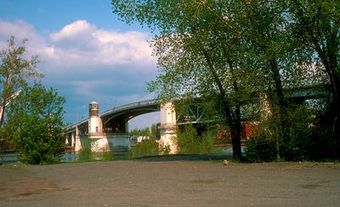
Grand-Mère
Grand-Mère, Québec, city, pop 13 179 (2001c), 14 223 (1996c), 14 287 (1991c), 14 582 (1986c), area 62.95 km2, inc 1898, is located on the ST-MAURICE RIVER, 35 km north of Trois-Rivières. The city takes its name from a large stone - bearing a startling resemblance to an old woman - which used to protrude in the middle of a nearby waterfall. In 1916 the stone was moved to the centre of town and is now a tourist attraction.
The first French missionary contact with the indigenous people, the MONTAGNAIS, took place in 1651, but the region remained virtually unsettled for nearly 200 years. In the 1830s some lumbermen began to work the area, and for the next half-century some small-scale trapping and logging on the St-Maurice constituted the only economic activity.
Grand-Mère owes its existence to the building in 1890 of a hydroelectric power station on the site of Grand-Mère Falls by Montréal businessman John Forman. This attracted many industries which are still active in the city. Grand-Mère has grown significantly since 1945, and it experienced an economic boom when a dam was built there in the mid-1970s, temporarily swelling the population to nearly 20 000.
Grand-Mère is an important railway and river transportation centre serving the lumber, pulp and paper, hydroelectric and textile industries operating in and around the municipality. It is also a major supplier of service industries.

 Share on Facebook
Share on Facebook Share on X
Share on X Share by Email
Share by Email Share on Google Classroom
Share on Google Classroom

